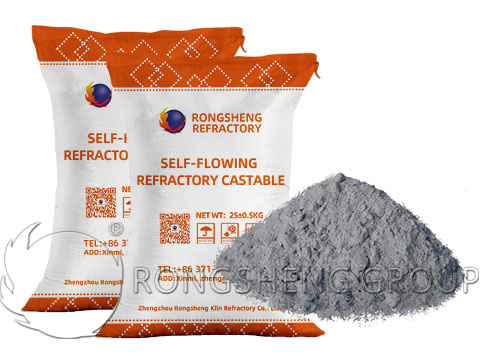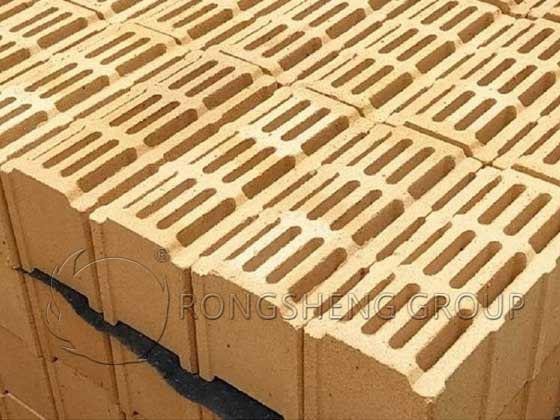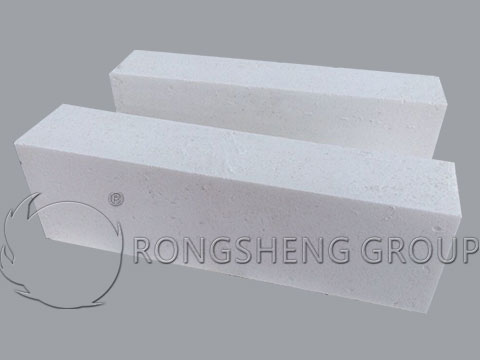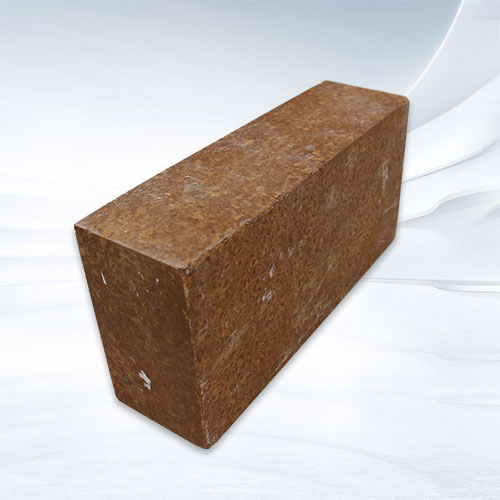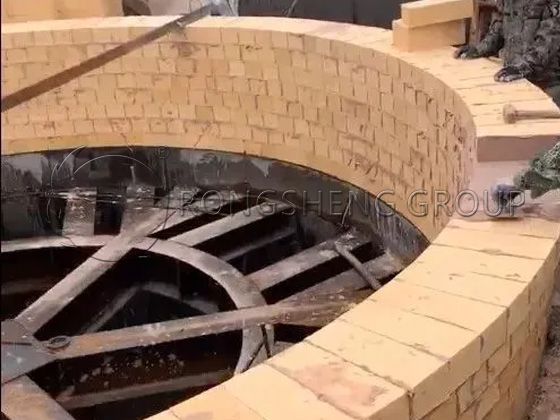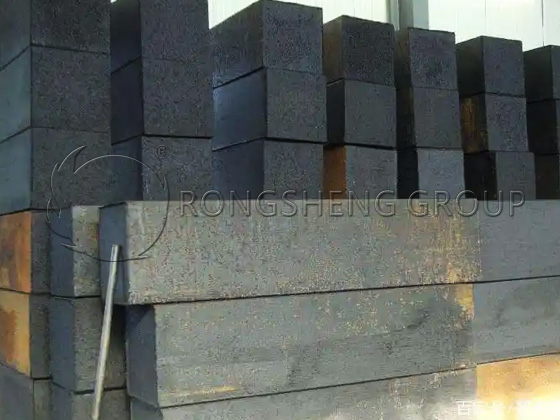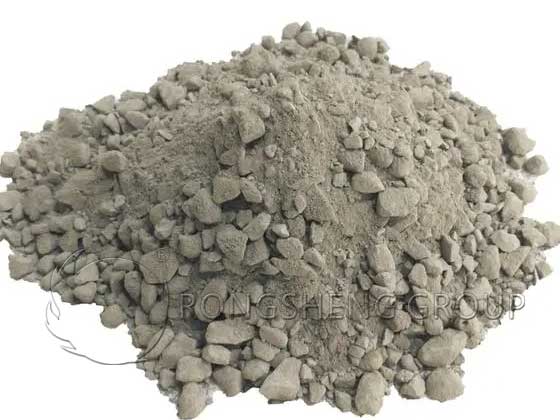-
Semi-dry pressing
During the semi-dry pressing process, the loose materials do not have enough moisture and must be subjected to greater pressure. With the help of pressure, the blank particles are redistributed. Under the action of mechanical bonding force, electrostatic attraction and friction, the blank particles are tightly combined, elastic deformation and brittle deformation occur, air is discharged, and the blank particles are combined into products with a certain size, shape and strength.
The degree of action of the above forces depends on the particle shape, the physical and chemical properties of the blank and the surface state of the particles. For particles with complex shapes, mechanical bonding force plays a major role. For particles with simple shapes, friction and static electricity cause the main effects.
Within a certain range when other process conditions are the same, the pressure increases during pressing, the porosity of the blank decreases, the density increases, and the strength increases accordingly.
The blanks and bricks of refractory materials are three-phase systems composed of solid matter, water (or other binders in other states) and air. During the entire pressing process, because the amount of phase and liquid phase does not change, the amount of air in the blank is compressed and reduced, and the volume of the compressed blank is also reduced accordingly.
-
Slurry injection molding method
Use powdered raw materials, select appropriate degumming agents (deflocculating agents) to evenly suspend them in the solution, adjust them into mud, pour them into a water-absorbent mold (generally a gypsum mold) to absorb water, and form a green body according to the shape of the model. This method is called slurry injection molding.
For materials that do not react with water, water is generally used as a suspension, and the moisture content of the mud is as high as 35~45%. For some materials that are easy to react with water, such as CaO, MgO, etc., organic matter can be used as a suspension, such as anhydrous alcohol. This method is suitable for the production of thin-walled hollow products. Such as thermocouple sleeves, high-temperature furnace tubes and crucibles. Various oxide products, from small to large pieces, have adopted this method.
For thin-walled hollow products, hollow casting is generally used. Inject mud into the model, and after a certain period of time, the raw materials are adsorbed on the model wall. When the specified thickness is absorbed, the internal mud is discharged. Dry to an appropriate degree and then demold, the gypsum mold can be used repeatedly. The mud used should have good fluidity, and the density is generally between 1.65~1.80g/cm2.
For the casting of thick and large products, solid casting is suitable. The mud used should be large, and the density should generally be above 1.8g/cm3. The thick mud has thixotropy, so it should be strongly mechanically stirred before casting to make it fluid. After casting, it can be solidified by standing for a period of time. Therefore, the plaster mold used does not need to have high water absorption.
-
Plastic molding method
The moisture content of the blank used in the plastic method is generally above 16%. The prefabricated blank is put into the mud extruder, extruded into mud strips, and then cut. Then the blank is made into a blank according to the required size, and the blank is pressed by a press to make the blank have the specified size and shape.
The moisture content of the blank is related to different raw materials and products. For plastic clay materials, the moisture content can be appropriately reduced to 10~15%. The critical pressure of the mud extruder is related to the moisture content of the blank.
The plastic molding method is mostly used to prepare large products. Depending on the molding operation, it can be formed by hand, semi-mechanical (such as clamping hammer) or machine pressing.
With the improvement of refractory process technology and the development of molding machinery and equipment, the application of plastic molding methods in the refractory industry has a tendency to decrease.
-
Vibration molding
When the material vibrates at a frequency of about 3,000 times per minute, the particles of the blank collide with each other, and dynamic friction replaces the static friction between the particles, and the blank becomes a fluid particle. Due to the energy input by the vibration, the particles have the ability to move in three dimensions inside the blank, so that the particles can be densely packed and filled in every corner of the model and the air can be squeezed out. Therefore, even under very small pressure, a high-density product can be obtained. When molding a variety of products, vibration molding can effectively replace heavy high-pressure brick presses. For example, crank lever brick presses and hydraulic presses can mold complex special-shaped and giant bricks that require manual molding or ramming molding, greatly improving labor productivity and reducing labor intensity. Vibration molding is also suitable for molding materials with a large difference in density and molding fragile brittle materials. Since the material particles are not destroyed during molding, it is suitable for molding easily hydrated materials, such as tar dolomite, tar magnesia, etc.
-
Hot Pressing
Refractory products made by sintering require a long calcination time, and the porosity is still as high as 10~25%. Ceramic materials and products prepared by sintering still have a true porosity of 3~5% even under ideal conditions. Non-oxide ceramic materials, such as carbides and nitrides, have even greater porosity.
It is difficult to make very dense products. This is because during the sintering process, the gas pressure in the pores increases, offsetting the role of the interface energy as a driving force. On the other hand, closed pores can only be filled by diffusion of substances inside the crystal, but internal diffusion is much slower than interface diffusion. If the sintering process is carried out to the final stage and the product reaches an ideal dense state, there are two methods:
- One is to use vacuum sintering to avoid gas accumulation in the pores.
- The other is to apply pressure during sintering to ensure sufficient driving force.
The latter is called hot pressing.
Compared with the common sintering method, the advantage of hot pressing is that it can obtain special products with very high density, and its density value can almost reach the theoretical value. Adjusting the hot pressing conditions can control the grain formation, and hot pressing at high temperature is conducive to the contact and diffusion between particles. Thus, the sintering temperature is reduced (compared with the common sintering method).
-
Hot Pressing Molding (Hot Pressing Grouting)
Hot pressing is one of the grouting methods and is a relatively new method for producing ceramic products and special refractory materials.
Hot pressing generally uses an organic binder as a dispersion medium and silicate mineral powder as a dispersed phase. At a certain temperature (70~85℃), it is prepared into a slurry and then molded into a metal model. This method is suitable for the production of small products with complex shapes and special requirements. It is also suitable for the production of materials with low plasticity, such as the molding of high-aluminum materials. Its semi-finished products have high mechanical strength and can be turned and drilled by machine tools. The plaster model and drying process can be omitted, the equipment is simple, and mechanization is easy to achieve.
-
Electric Melting Method
The refractory raw materials are melted in an electric arc furnace, and then the melt is poured into a refractory casting mold for casting. Because the fluidity of the fluid must be good, the general pouring temperature must be between 1900~2000℃. The casting generates a stable crystal phase during the solidification process and forms a fine crystalline structure. After pouring, the casting mouth should be removed, and the casting should be slowly cooled for several days to prevent cracks from appearing during cooling. The casting block is finally processed on the surface to become a product. The products formed by this method are mainly fused zirconium mullite bricks, chrome corundum bricks, and fused quartz bricks. It is mainly used to build the bottom of the glass tank kiln. Most of the raw materials for producing rebonded bricks are also produced by this method.
-
Isostatic Pressing
Isostatic pressing is a new forming technology developed later. This method mainly applies the Pascal principle to pressurize the liquid and evenly transfer its pressure to the powder through the rubber film, so it has the following characteristics.
- Formability. The pressurization is non-directional, and a green body with uniform density can be obtained, and there will be no layer density phenomenon during other mechanical pressing. It is easy to press into products with complex shapes.
- Sinterability. Since the green body has uniform density and shrinkage during firing is non-directional, it will not cause stress due to density difference and cause firing cracks. Due to the high density, the firing temperature is relatively reduced.
The main equipment consists of a high-pressure container and a high-pressure pump. During molding, the powdered material is placed in a rubber film or a plastic film, placed in an ultra-high-pressure container with a thick steel wall, and a high-pressure liquid is injected by a high-pressure pump. The working pressure is generally above 343MPa. This method only formed small products at the beginning, and has now developed to press large products.

